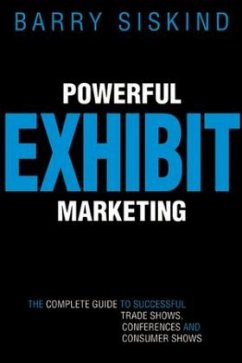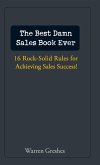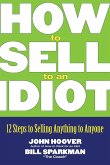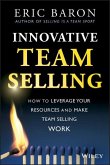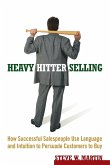Barry Siskind
Powerful Exhibit Marketing
The Complete Guide to Successful Trade Shows, Conferences and Consumer Shows
Barry Siskind
Powerful Exhibit Marketing
The Complete Guide to Successful Trade Shows, Conferences and Consumer Shows
- Broschiertes Buch
- Merkliste
- Auf die Merkliste
- Bewerten Bewerten
- Teilen
- Produkt teilen
- Produkterinnerung
- Produkterinnerung
A complete guide to successful trade shows and exhibitions Trade shows, consumer shows, product launches, sporting events, and other opportunities to interact face-to-face with customers are becoming an increasingly important aspect of overall marketing. In The Power of Exhibit Marketing, professional exhibition consultant Barry Siskind offers proven, step-by-step advice for successful exhibits at trade shows and other events. Definitive and comprehensive, this book shows exhibit organizers how to set objectives, budget for events, find the right audience, turn leads into business, design…mehr
Andere Kunden interessierten sich auch für
![The Best Damn Sales Book Ever The Best Damn Sales Book Ever]() Warren GreshesThe Best Damn Sales Book Ever23,99 €
Warren GreshesThe Best Damn Sales Book Ever23,99 €![How to Sell to an Idiot How to Sell to an Idiot]() John HooverHow to Sell to an Idiot15,99 €
John HooverHow to Sell to an Idiot15,99 €![Guerrilla Negotiation Guerrilla Negotiation]() Conrad J. LevinsonGuerrilla Negotiation38,99 €
Conrad J. LevinsonGuerrilla Negotiation38,99 €![The Contrarian Effect The Contrarian Effect]() Michael PortThe Contrarian Effect16,99 €
Michael PortThe Contrarian Effect16,99 €![Innovative Team Selling Innovative Team Selling]() Eric BaronInnovative Team Selling20,99 €
Eric BaronInnovative Team Selling20,99 €![Playing Bigger Than You Are Playing Bigger Than You Are]() William T. BrooksPlaying Bigger Than You Are23,99 €
William T. BrooksPlaying Bigger Than You Are23,99 €![Heavy Hitter Selling Heavy Hitter Selling]() Steve W. MartinHeavy Hitter Selling18,99 €
Steve W. MartinHeavy Hitter Selling18,99 €-
-
-
A complete guide to successful trade shows and exhibitions
Trade shows, consumer shows, product launches, sporting events, and other opportunities to interact face-to-face with customers are becoming an increasingly important aspect of overall marketing. In The Power of Exhibit Marketing, professional exhibition consultant Barry Siskind offers proven, step-by-step advice for successful exhibits at trade shows and other events. Definitive and comprehensive, this book shows exhibit organizers how to set objectives, budget for events, find the right audience, turn leads into business, design great booths, work the show, gather intelligence, measure success, and much more.
Barry Siskind (Terra Cotta, Ontario, Canada) is President of International Training and Management, a professional speaker, and one of North America's foremost trade and consumer show experts. He is also the author of Bumblebees Can't Fly (0-470-83439-0) and Eagles Must Soar (0-470-83468-4).
Hinweis: Dieser Artikel kann nur an eine deutsche Lieferadresse ausgeliefert werden.
Trade shows, consumer shows, product launches, sporting events, and other opportunities to interact face-to-face with customers are becoming an increasingly important aspect of overall marketing. In The Power of Exhibit Marketing, professional exhibition consultant Barry Siskind offers proven, step-by-step advice for successful exhibits at trade shows and other events. Definitive and comprehensive, this book shows exhibit organizers how to set objectives, budget for events, find the right audience, turn leads into business, design great booths, work the show, gather intelligence, measure success, and much more.
Barry Siskind (Terra Cotta, Ontario, Canada) is President of International Training and Management, a professional speaker, and one of North America's foremost trade and consumer show experts. He is also the author of Bumblebees Can't Fly (0-470-83439-0) and Eagles Must Soar (0-470-83468-4).
Hinweis: Dieser Artikel kann nur an eine deutsche Lieferadresse ausgeliefert werden.
Produktdetails
- Produktdetails
- Verlag: Wiley & Sons
- Artikelnr. des Verlages: 14583469000
- 1. Auflage
- Seitenzahl: 320
- Erscheinungstermin: 1. März 2005
- Englisch
- Abmessung: 231mm x 154mm x 22mm
- Gewicht: 435g
- ISBN-13: 9780470834695
- ISBN-10: 0470834692
- Artikelnr.: 13481010
- Herstellerkennzeichnung
- Libri GmbH
- Europaallee 1
- 36244 Bad Hersfeld
- gpsr@libri.de
- Verlag: Wiley & Sons
- Artikelnr. des Verlages: 14583469000
- 1. Auflage
- Seitenzahl: 320
- Erscheinungstermin: 1. März 2005
- Englisch
- Abmessung: 231mm x 154mm x 22mm
- Gewicht: 435g
- ISBN-13: 9780470834695
- ISBN-10: 0470834692
- Artikelnr.: 13481010
- Herstellerkennzeichnung
- Libri GmbH
- Europaallee 1
- 36244 Bad Hersfeld
- gpsr@libri.de
BARRY SISKIND, President of International Training and Management, is one of North America's foremost trade and consumer show experts, and a sought-after professional speaker. He conducts workshops and speaks to 30,000-40,000 people across North America and internationally each year. Siskind's clients include Nortel Networks, JDS Uniphase, Novartis, Glaxo-Smith Klein, Bank of Montreal, and Royal Bank of Canada. He is the trainer of choice for DMG World Media (one of the largest trade show operators in the world), and Nimlok (the second largest booth manufacturer in the world). Siskind has written over 500 original articles for trade and consumer publications, including The Globe and Mail, Marketing, and Exhibitor Magazine. He is also the author of Bumblebees Can't Fly, Eagles Must Soar, and Making Contact.
Acknowledgments.
Introduction.
What Is Exhibit Management?
PART ONE: MANAGING THE FISCAL RESOURCES.
Chapter 1. Exhibiting Objectives.
Three Levels of Exhibit Objectives.
Get Focused.
Quantify Your Objectives.
In Conclusion.
Chapter 2. Budgeting and Financial Management.
Calculate the Amount of Exhibit Space Required.
The Final Budget.
Financial Management.
Exhibit Annual Report.
In Conclusion.
Chapter 3. Choosing the Right Event.
Understand Your Objectives.
Define Your Audience.
Establish a Customer Profile.
Focus on Your Market.
Rank Your Customer Profiles in Order of Priority.
Where Do You Find Places to Exhibit?
How to Choose the Right Event.
Where to Find Suitable Events.
In Conclusion.
PART TWO: MANAGING THE PHYSICAL ASPECTS.
Chapter 4. Create Your Three-Dimensional Marketing Experience.
Creating the Experience.
Interest.
Memorability.
Connectivity.
Developing Your Display Needs Analysis.
Create a Request for Proposal (RFP).
The Design Schedule.
In Conclusion.
Chapter 5. Your Display-the Nuts and Bolts.
System: Custom or Hybrid?
Color.
Lighting.
Flooring.
Signs and Graphics.
Technology.
Booth Configuration.
Layouts.
Height.
Customs and Duty.
Storage.
Emergency Supplies Box.
In Conclusion.
Chapter 6. Enhancements.
Location.
Plants and Flowers.
Hospitality.
Demonstrations.
Collateral Material.
Draws.
In-Booth Activities.
Promotional Products.
Sponsorships.
In Conclusion.
Chapter 7. Pre-Show Promotion.
Invitations.
Public Relations.
Advertising.
Web Announcements.
Other Promotional Ideas.
In Conclusion.
PART THREE: MANAGING THE HUMAN RESOURCES.
Chapter 8. Pre-Show Briefing.
Attendees' Behavior.
Booth Staff Personality.
The Third Element: The Type of Training.
In Conclusion.
Chapter 9. The Four Stages of Boothing.
Stage 1. Entry Level.
Stage 2: Better but Still a Long Way to Go.
Stage 3: The First Sign of Real Improvement.
Stage 4: Where Real Results Are Found.
The Skills.
The Six People You Are Likely to Meet at a Trade Show.
Motivate the Doers.
In Conclusion.
Chapter 10. Breaking the Ice.
Do #1: Ask Open Questions.
Do #2: Focus on Business.
Don't #1: Don't Ask a Question If You Don't Want the Answer.
Don't #2: Don't Ask a Question If You Don't Know What to Do with the
Answer.
Don't #3: Don't Ask a Question That Leads to a Pitch.
Three Ice-Breaking Scenarios.
In Conclusion.
Chapter 11. Gathering Information.
A = Authority.
C = Capability.
T = Time.
I = Identity.
O = Obstacles.
N = Need.
In Conclusion.
Chapter 12. Making Effective Show Presentations.
Maintain Focus.
Good Time Management Practices.
The Presentation.
In Conclusion.
Chapter 13. Disengaging.
The Presumptive Disengagement.
The Conciliatory Disengagement.
In Conclusion.
Chapter 14. Developing Rapport with Potential Clients.
Words.
Para-Verbal.
Nonverbal.
Prior to Approaching.
Rapport during the Ice Breaker.
Rapport during Information Gathering.
What to Look for.
Maslow's Hierarchy and the Rapport-Building Process.
Rapport during the Disengagement.
In Conclusion.
Chapter 15. Turning Leads into Business.
Sales Objectives.
Sample Letters.
Continuous Follow-up.
Stay in Touch.
Communication Objectives.
A Guideline for Creating Your Follow-up Plan.
A Note About Privacy.
In Conclusion.
Chapter 16. Gathering Strategic Intelligence at a Show.
Your Strategic Intelligence Team.
Your Strategic Intelligence Plan.
Step 1: Set Up Definitions and Objectives.
Step 2: Do the Research.
Step 3: Assign Responsibilities and Create a Schedule for Your Strategic
Intelligence Team.
Step 4: Gathering the Information.
Step 5: Develop the Walking Plan.
Step 6: Strategic Intelligence Overlap.
Step 7: Combat Information Overload.
Step 8: Evaluate Your Results.
In Conclusion.
Index.
Introduction.
What Is Exhibit Management?
PART ONE: MANAGING THE FISCAL RESOURCES.
Chapter 1. Exhibiting Objectives.
Three Levels of Exhibit Objectives.
Get Focused.
Quantify Your Objectives.
In Conclusion.
Chapter 2. Budgeting and Financial Management.
Calculate the Amount of Exhibit Space Required.
The Final Budget.
Financial Management.
Exhibit Annual Report.
In Conclusion.
Chapter 3. Choosing the Right Event.
Understand Your Objectives.
Define Your Audience.
Establish a Customer Profile.
Focus on Your Market.
Rank Your Customer Profiles in Order of Priority.
Where Do You Find Places to Exhibit?
How to Choose the Right Event.
Where to Find Suitable Events.
In Conclusion.
PART TWO: MANAGING THE PHYSICAL ASPECTS.
Chapter 4. Create Your Three-Dimensional Marketing Experience.
Creating the Experience.
Interest.
Memorability.
Connectivity.
Developing Your Display Needs Analysis.
Create a Request for Proposal (RFP).
The Design Schedule.
In Conclusion.
Chapter 5. Your Display-the Nuts and Bolts.
System: Custom or Hybrid?
Color.
Lighting.
Flooring.
Signs and Graphics.
Technology.
Booth Configuration.
Layouts.
Height.
Customs and Duty.
Storage.
Emergency Supplies Box.
In Conclusion.
Chapter 6. Enhancements.
Location.
Plants and Flowers.
Hospitality.
Demonstrations.
Collateral Material.
Draws.
In-Booth Activities.
Promotional Products.
Sponsorships.
In Conclusion.
Chapter 7. Pre-Show Promotion.
Invitations.
Public Relations.
Advertising.
Web Announcements.
Other Promotional Ideas.
In Conclusion.
PART THREE: MANAGING THE HUMAN RESOURCES.
Chapter 8. Pre-Show Briefing.
Attendees' Behavior.
Booth Staff Personality.
The Third Element: The Type of Training.
In Conclusion.
Chapter 9. The Four Stages of Boothing.
Stage 1. Entry Level.
Stage 2: Better but Still a Long Way to Go.
Stage 3: The First Sign of Real Improvement.
Stage 4: Where Real Results Are Found.
The Skills.
The Six People You Are Likely to Meet at a Trade Show.
Motivate the Doers.
In Conclusion.
Chapter 10. Breaking the Ice.
Do #1: Ask Open Questions.
Do #2: Focus on Business.
Don't #1: Don't Ask a Question If You Don't Want the Answer.
Don't #2: Don't Ask a Question If You Don't Know What to Do with the
Answer.
Don't #3: Don't Ask a Question That Leads to a Pitch.
Three Ice-Breaking Scenarios.
In Conclusion.
Chapter 11. Gathering Information.
A = Authority.
C = Capability.
T = Time.
I = Identity.
O = Obstacles.
N = Need.
In Conclusion.
Chapter 12. Making Effective Show Presentations.
Maintain Focus.
Good Time Management Practices.
The Presentation.
In Conclusion.
Chapter 13. Disengaging.
The Presumptive Disengagement.
The Conciliatory Disengagement.
In Conclusion.
Chapter 14. Developing Rapport with Potential Clients.
Words.
Para-Verbal.
Nonverbal.
Prior to Approaching.
Rapport during the Ice Breaker.
Rapport during Information Gathering.
What to Look for.
Maslow's Hierarchy and the Rapport-Building Process.
Rapport during the Disengagement.
In Conclusion.
Chapter 15. Turning Leads into Business.
Sales Objectives.
Sample Letters.
Continuous Follow-up.
Stay in Touch.
Communication Objectives.
A Guideline for Creating Your Follow-up Plan.
A Note About Privacy.
In Conclusion.
Chapter 16. Gathering Strategic Intelligence at a Show.
Your Strategic Intelligence Team.
Your Strategic Intelligence Plan.
Step 1: Set Up Definitions and Objectives.
Step 2: Do the Research.
Step 3: Assign Responsibilities and Create a Schedule for Your Strategic
Intelligence Team.
Step 4: Gathering the Information.
Step 5: Develop the Walking Plan.
Step 6: Strategic Intelligence Overlap.
Step 7: Combat Information Overload.
Step 8: Evaluate Your Results.
In Conclusion.
Index.
Acknowledgments.
Introduction.
What Is Exhibit Management?
PART ONE: MANAGING THE FISCAL RESOURCES.
Chapter 1. Exhibiting Objectives.
Three Levels of Exhibit Objectives.
Get Focused.
Quantify Your Objectives.
In Conclusion.
Chapter 2. Budgeting and Financial Management.
Calculate the Amount of Exhibit Space Required.
The Final Budget.
Financial Management.
Exhibit Annual Report.
In Conclusion.
Chapter 3. Choosing the Right Event.
Understand Your Objectives.
Define Your Audience.
Establish a Customer Profile.
Focus on Your Market.
Rank Your Customer Profiles in Order of Priority.
Where Do You Find Places to Exhibit?
How to Choose the Right Event.
Where to Find Suitable Events.
In Conclusion.
PART TWO: MANAGING THE PHYSICAL ASPECTS.
Chapter 4. Create Your Three-Dimensional Marketing Experience.
Creating the Experience.
Interest.
Memorability.
Connectivity.
Developing Your Display Needs Analysis.
Create a Request for Proposal (RFP).
The Design Schedule.
In Conclusion.
Chapter 5. Your Display-the Nuts and Bolts.
System: Custom or Hybrid?
Color.
Lighting.
Flooring.
Signs and Graphics.
Technology.
Booth Configuration.
Layouts.
Height.
Customs and Duty.
Storage.
Emergency Supplies Box.
In Conclusion.
Chapter 6. Enhancements.
Location.
Plants and Flowers.
Hospitality.
Demonstrations.
Collateral Material.
Draws.
In-Booth Activities.
Promotional Products.
Sponsorships.
In Conclusion.
Chapter 7. Pre-Show Promotion.
Invitations.
Public Relations.
Advertising.
Web Announcements.
Other Promotional Ideas.
In Conclusion.
PART THREE: MANAGING THE HUMAN RESOURCES.
Chapter 8. Pre-Show Briefing.
Attendees' Behavior.
Booth Staff Personality.
The Third Element: The Type of Training.
In Conclusion.
Chapter 9. The Four Stages of Boothing.
Stage 1. Entry Level.
Stage 2: Better but Still a Long Way to Go.
Stage 3: The First Sign of Real Improvement.
Stage 4: Where Real Results Are Found.
The Skills.
The Six People You Are Likely to Meet at a Trade Show.
Motivate the Doers.
In Conclusion.
Chapter 10. Breaking the Ice.
Do #1: Ask Open Questions.
Do #2: Focus on Business.
Don't #1: Don't Ask a Question If You Don't Want the Answer.
Don't #2: Don't Ask a Question If You Don't Know What to Do with the
Answer.
Don't #3: Don't Ask a Question That Leads to a Pitch.
Three Ice-Breaking Scenarios.
In Conclusion.
Chapter 11. Gathering Information.
A = Authority.
C = Capability.
T = Time.
I = Identity.
O = Obstacles.
N = Need.
In Conclusion.
Chapter 12. Making Effective Show Presentations.
Maintain Focus.
Good Time Management Practices.
The Presentation.
In Conclusion.
Chapter 13. Disengaging.
The Presumptive Disengagement.
The Conciliatory Disengagement.
In Conclusion.
Chapter 14. Developing Rapport with Potential Clients.
Words.
Para-Verbal.
Nonverbal.
Prior to Approaching.
Rapport during the Ice Breaker.
Rapport during Information Gathering.
What to Look for.
Maslow's Hierarchy and the Rapport-Building Process.
Rapport during the Disengagement.
In Conclusion.
Chapter 15. Turning Leads into Business.
Sales Objectives.
Sample Letters.
Continuous Follow-up.
Stay in Touch.
Communication Objectives.
A Guideline for Creating Your Follow-up Plan.
A Note About Privacy.
In Conclusion.
Chapter 16. Gathering Strategic Intelligence at a Show.
Your Strategic Intelligence Team.
Your Strategic Intelligence Plan.
Step 1: Set Up Definitions and Objectives.
Step 2: Do the Research.
Step 3: Assign Responsibilities and Create a Schedule for Your Strategic
Intelligence Team.
Step 4: Gathering the Information.
Step 5: Develop the Walking Plan.
Step 6: Strategic Intelligence Overlap.
Step 7: Combat Information Overload.
Step 8: Evaluate Your Results.
In Conclusion.
Index.
Introduction.
What Is Exhibit Management?
PART ONE: MANAGING THE FISCAL RESOURCES.
Chapter 1. Exhibiting Objectives.
Three Levels of Exhibit Objectives.
Get Focused.
Quantify Your Objectives.
In Conclusion.
Chapter 2. Budgeting and Financial Management.
Calculate the Amount of Exhibit Space Required.
The Final Budget.
Financial Management.
Exhibit Annual Report.
In Conclusion.
Chapter 3. Choosing the Right Event.
Understand Your Objectives.
Define Your Audience.
Establish a Customer Profile.
Focus on Your Market.
Rank Your Customer Profiles in Order of Priority.
Where Do You Find Places to Exhibit?
How to Choose the Right Event.
Where to Find Suitable Events.
In Conclusion.
PART TWO: MANAGING THE PHYSICAL ASPECTS.
Chapter 4. Create Your Three-Dimensional Marketing Experience.
Creating the Experience.
Interest.
Memorability.
Connectivity.
Developing Your Display Needs Analysis.
Create a Request for Proposal (RFP).
The Design Schedule.
In Conclusion.
Chapter 5. Your Display-the Nuts and Bolts.
System: Custom or Hybrid?
Color.
Lighting.
Flooring.
Signs and Graphics.
Technology.
Booth Configuration.
Layouts.
Height.
Customs and Duty.
Storage.
Emergency Supplies Box.
In Conclusion.
Chapter 6. Enhancements.
Location.
Plants and Flowers.
Hospitality.
Demonstrations.
Collateral Material.
Draws.
In-Booth Activities.
Promotional Products.
Sponsorships.
In Conclusion.
Chapter 7. Pre-Show Promotion.
Invitations.
Public Relations.
Advertising.
Web Announcements.
Other Promotional Ideas.
In Conclusion.
PART THREE: MANAGING THE HUMAN RESOURCES.
Chapter 8. Pre-Show Briefing.
Attendees' Behavior.
Booth Staff Personality.
The Third Element: The Type of Training.
In Conclusion.
Chapter 9. The Four Stages of Boothing.
Stage 1. Entry Level.
Stage 2: Better but Still a Long Way to Go.
Stage 3: The First Sign of Real Improvement.
Stage 4: Where Real Results Are Found.
The Skills.
The Six People You Are Likely to Meet at a Trade Show.
Motivate the Doers.
In Conclusion.
Chapter 10. Breaking the Ice.
Do #1: Ask Open Questions.
Do #2: Focus on Business.
Don't #1: Don't Ask a Question If You Don't Want the Answer.
Don't #2: Don't Ask a Question If You Don't Know What to Do with the
Answer.
Don't #3: Don't Ask a Question That Leads to a Pitch.
Three Ice-Breaking Scenarios.
In Conclusion.
Chapter 11. Gathering Information.
A = Authority.
C = Capability.
T = Time.
I = Identity.
O = Obstacles.
N = Need.
In Conclusion.
Chapter 12. Making Effective Show Presentations.
Maintain Focus.
Good Time Management Practices.
The Presentation.
In Conclusion.
Chapter 13. Disengaging.
The Presumptive Disengagement.
The Conciliatory Disengagement.
In Conclusion.
Chapter 14. Developing Rapport with Potential Clients.
Words.
Para-Verbal.
Nonverbal.
Prior to Approaching.
Rapport during the Ice Breaker.
Rapport during Information Gathering.
What to Look for.
Maslow's Hierarchy and the Rapport-Building Process.
Rapport during the Disengagement.
In Conclusion.
Chapter 15. Turning Leads into Business.
Sales Objectives.
Sample Letters.
Continuous Follow-up.
Stay in Touch.
Communication Objectives.
A Guideline for Creating Your Follow-up Plan.
A Note About Privacy.
In Conclusion.
Chapter 16. Gathering Strategic Intelligence at a Show.
Your Strategic Intelligence Team.
Your Strategic Intelligence Plan.
Step 1: Set Up Definitions and Objectives.
Step 2: Do the Research.
Step 3: Assign Responsibilities and Create a Schedule for Your Strategic
Intelligence Team.
Step 4: Gathering the Information.
Step 5: Develop the Walking Plan.
Step 6: Strategic Intelligence Overlap.
Step 7: Combat Information Overload.
Step 8: Evaluate Your Results.
In Conclusion.
Index.

